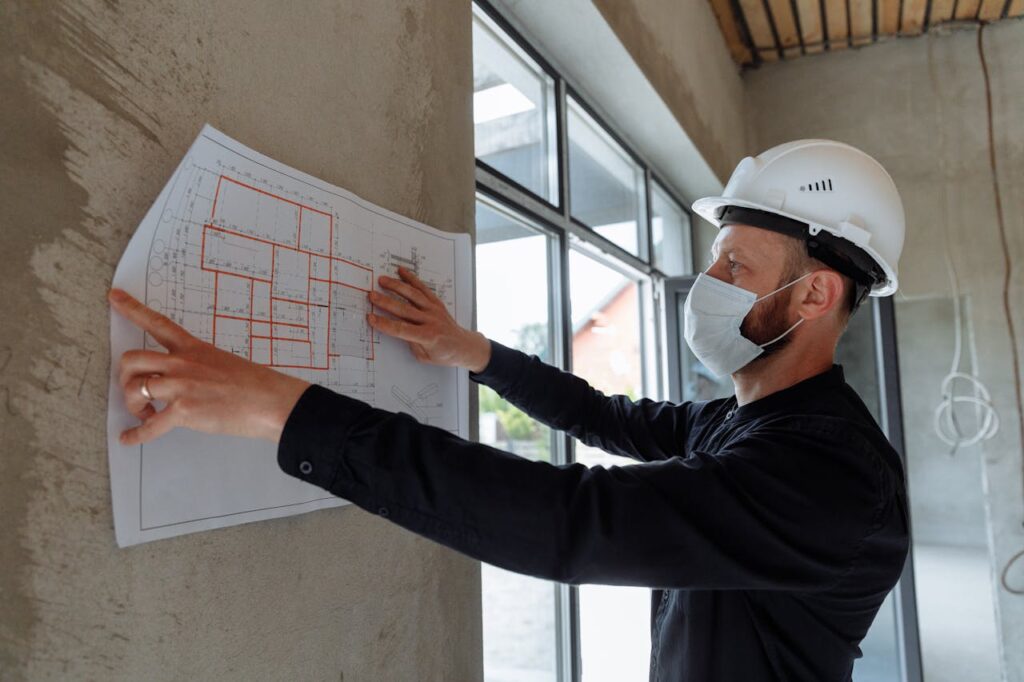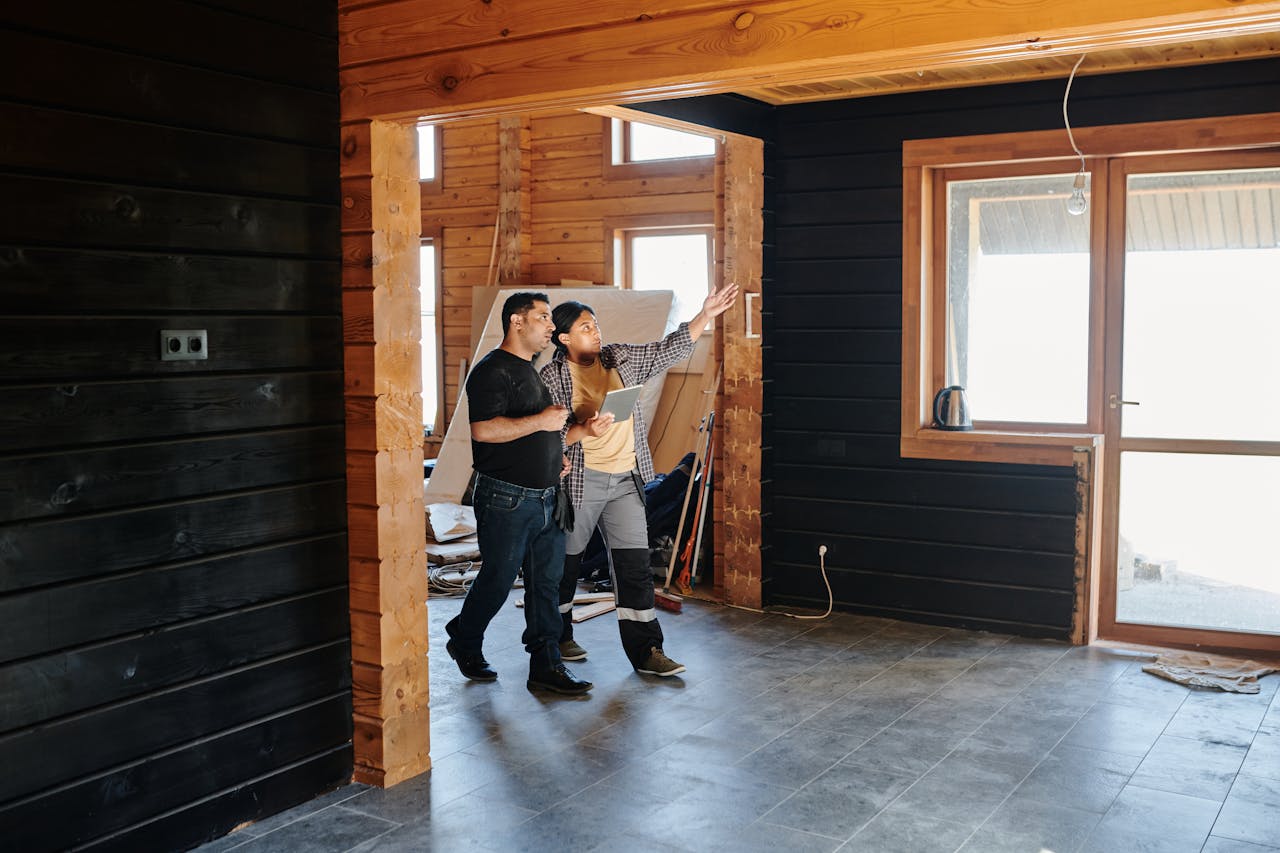Commercial general contractor fees typically range from 10% to 20% of the total project cost. Some commercial projects push this range to 20% to 25%, particularly when complex building systems and extensive coordination demands increase our scope of work.
These fees cover overhead and profit while accounting for the administrative work and risk we take on during commercial construction. We also apply additional markups to subcontractor labor and materials as part of our comprehensive project management approach.
Disclaimer: Pricing figures are based on publicly available market data and are intended for general estimation purposes as of October 2025. They do not represent a formal quote from EB3 Construction. Actual costs will vary by project scope, location, labor rates, and material prices.
How Are Commercial GC Fees Structured And What Do They Include?

We structure our fees through four primary methods, each designed to match different project requirements and risk profiles. The percentage-of-cost approach remains most common, typically ranging from 10% to 20% of total project cost, though commercial projects with complex systems and coordination demands often reach 20% to 25%.
Fixed-price agreements, also called lump sum contracts, establish a set fee regardless of cost fluctuations. Cost-plus structures bill actual expenses plus a predetermined percentage for overhead and profit. Time and materials contracts charge based on hours worked and materials consumed, offering flexibility when project scope remains uncertain.
What These Fees Cover
Our fees encompass multiple cost components beyond basic supervision. Overhead expenses include office operations, insurance, equipment maintenance, and administrative support. Profit margins ensure business sustainability and risk coverage for unexpected challenges.
We apply markups to subcontractor services and materials to cover our management, coordination, and quality oversight responsibilities. These markups account for the extensive coordination required to sequence trades, maintain safety standards, and ensure code compliance across all work elements.
Markup Ranges On Labor And Materials
Individual line-item markups typically range from 8% to 45%, depending on the complexity and risk associated with specific work elements. Subcontractor markups commonly fall within the 30% to 45% range, reflecting our role in vetting, coordinating, and managing specialized trades.
| Project Type | General Contractor Fee Range | Typical Markup on Materials | Typical Markup on Labor |
|---|---|---|---|
| Residential Construction | 10% – 20% | 30% – 50% | 25% |
| Commercial Construction | 20% – 25% | Varies | 15% – 20% |
Pre-Construction Services
Planning consultation and estimating services typically add $150 to over $1,000, scaling with project complexity and size. These services include feasibility studies, preliminary cost analysis, construction scheduling, and value engineering recommendations.
During pre-construction, we collaborate with design teams to identify potential construction challenges, suggest alternative approaches, and refine cost estimates. This investment in upfront planning reduces change orders and schedule delays, ultimately benefiting project outcomes and budget control.
Which Factors Influence the Fee Percentage on Commercial Projects?
Commercial construction fees fluctuate based on several interconnected factors that directly impact project costs. Project complexity drives fee percentages higher when specialized coordination is required. Location determines labor rates and regulatory demands that affect our overall pricing structure.
Project Size and Complexity Drive Fee Structure
Larger projects typically command lower percentage fees due to economies of scale. A $10 million office building may carry a 12% fee while a $500,000 tenant improvement could require 18-22%. Complex designs with custom architectural features increase coordination time and technical expertise requirements.
Multi-story buildings demand enhanced safety protocols and vertical logistics management. Specialized commercial types like healthcare facilities require compliance with strict codes that increase our administrative overhead. Restaurant projects need intricate kitchen ventilation coordination that pushes fees toward the higher end of typical ranges.
Labor and Material Costs Shape Pricing
Rising labor costs in skilled trades directly impact our fee calculations. When electrician wages increase 15% year-over-year, we adjust our markups to maintain project viability. Material price volatility creates additional risk that we factor into percentage-based fees.
Steel price fluctuations can swing project costs by hundreds of thousands of dollars. We account for this volatility when establishing fee percentages at contract signing. Specialized materials like medical-grade flooring or commercial kitchen equipment require vendor coordination that increases our management scope.
Geographic Location Affects Market Conditions
Urban projects face higher labor rates and stricter building codes than rural construction. Manhattan office buildouts carry different fee structures than similar projects in smaller markets. City permitting processes require more administrative time and regulatory expertise.
Coastal markets with seismic requirements need specialized engineering coordination. Cold-weather regions demand enhanced scheduling around weather delays. We adjust our fees based on local market conditions and regulatory complexity in each project location.
Commercial Building Systems Impact Coordination Needs
HVAC system complexity varies significantly between building types. A basic warehouse requires minimal mechanical coordination while a data center demands precise environmental controls. Electrical systems in manufacturing facilities need specialized load calculations and safety protocols.
Plumbing requirements escalate dramatically in restaurant and healthcare projects. Multi-tenant office buildings require sophisticated fire suppression systems that increase our coordination responsibilities. Each building system adds layers of subcontractor management that influence our fee percentage.
Market Conditions and Schedule Pressure
Tight construction markets with limited contractor availability push fees higher. When skilled subcontractors are scarce, we invest more time in procurement and scheduling coordination. Accelerated schedules require overtime management and enhanced logistics planning.
Economic uncertainty creates material procurement challenges that increase our risk exposure. We monitor regional construction volume and adjust pricing accordingly. Scope clarity at contract signing helps control fees, while vague specifications increase our contingency requirements and fee percentages.
Which Pricing Methods Fit Your Risk And Budget Best?

Each pricing method shifts risk between property owner and contractor. Budget predictability comes with trade-offs in flexibility and cost transparency. The right choice depends on your project scope, timeline, and comfort with uncertainty.
Percentage-Of-Cost Methods
Percentage-of-cost structures scale the contractor’s fee with total project value. When we work on a $2 million project at 15%, our fee reaches $300,000. If costs rise to $2.5 million due to scope changes, the fee increases proportionally to $375,000.
This approach aligns our interests with efficient project management. Higher costs mean higher fees, but also greater responsibility for cost control. Property owners benefit from professional oversight that scales with project complexity.
The downside involves fee fluctuations as project costs change. Material price increases or design modifications directly impact the total fee. Budget planning becomes more challenging without fixed fee certainty.
Fixed Price And Lump Sum Contracts
Lump sum contracts offer maximum budget predictability for property owners. We provide a single price covering all construction costs, overhead, and profit. The owner pays this amount regardless of actual construction expenses.
Fixed pricing works best with complete design documents and clearly defined scope. We can accurately estimate costs when specifications are detailed and site conditions are known. Well-defined projects minimize the risk of cost overruns that reduce our profit margins.
The contractor absorbs all cost overrun risk in lump sum arrangements. If material prices spike or unforeseen site conditions emerge, we handle the additional expenses. This risk exposure typically results in higher initial bids to cover potential contingencies.
Cost-Plus Arrangements
Cost-plus contracts provide complete cost transparency and project flexibility. Property owners pay actual construction costs plus our predetermined fee or markup percentage. All labor, materials, equipment, and subcontractor expenses are reimbursed at cost.
This transparency allows real-time budget adjustments as scope changes occur. Design modifications during construction don’t trigger lengthy change order negotiations. We can respond quickly to owner requests without contract renegotiation delays.
Total project costs remain uncertain until completion in cost-plus structures. Scope changes can significantly impact final budgets without careful controls. Property owners assume the risk of cost increases but also capture any savings from efficient execution.
Time And Materials Approaches
Time and materials pricing suits projects with uncertain scope or duration. We bill actual labor hours at predetermined rates plus material costs with agreed markups. This method provides flexibility when project requirements evolve during construction.
Hourly rates typically range from $50 to $150 per hour depending on trade specialization and regional labor markets. Daily supervision rates fall between $300 and $1,500 based on project complexity and management requirements.
Set clear limits and tracking procedures to manage costs in time and materials contracts. Weekly spending caps or total budget ceilings prevent runaway expenses. Regular progress reports help property owners monitor costs against original estimates.
| Pricing Method | Risk Allocation | Budget Predictability |
|---|---|---|
| Percentage-of-Cost | Shared risk between property owner and contractor | Low due to fee fluctuations with cost changes |
| Fixed Price / Lump Sum | Contractor assumes risk of cost overruns | High; offers maximum budget predictability |
| Cost-Plus | Property owners assume risk of cost increases | Variable as costs are known only at completion |
| Time and Materials | Property owner assumes risk of duration and cost fluctuations | Uncertain; depends on project scope and construction duration |
Small scopes like tenant improvements or specific trades often use hourly or daily rates. Site supervision during specialty installations may warrant daily billing. These arrangements work well for defined tasks with predictable timeframes.
Choosing The Right Method
Project scope clarity drives pricing method selection. Complete designs and specifications support lump sum contracts with predictable budgets. Evolving designs favor cost-plus or time and materials approaches that accommodate changes.
Risk tolerance affects pricing decisions. Property owners seeking budget certainty choose fixed price contracts despite potentially higher bids. Those comfortable with cost fluctuations select cost-plus methods for potential savings and greater flexibility.
Project size influences method effectiveness. Large commercial projects often use guaranteed maximum price variations of cost-plus contracts. Small renovations or repairs suit time and materials billing for specific scopes.
How Do Payment Terms Typically Work, And How Do GCs Compare With Construction Managers?
Commercial construction payment schedules typically begin with an upfront deposit ranging from 10% to 25% of the total project cost. This initial payment secures our services and provides working capital to begin mobilization activities. We structure these deposits based on project size and risk factors.
Progress payments form the backbone of construction cash flow. We tie these payments to specific project milestones such as foundation completion, structural framing, MEP rough-in, and finish work phases. This milestone-based approach ensures payment aligns with actual work completed and value delivered to the project.
Clear payment schedules reduce disputes and improve project relationships. We establish defined payment terms that specify due dates, invoice requirements, and approval processes. Electronic payments are increasingly common in commercial construction, streamlining the payment process and reducing administrative overhead for both parties.
Construction Manager Fees And Project Involvement
Construction managers typically charge between 5% and 15% of total project cost, which often falls below general contractor fees. Their involvement begins earlier in the project lifecycle, during the design phase when they provide planning consultation and budgeting guidance. This early engagement helps optimize constructability and cost control.
Construction managers focus on overall project coordination and budget oversight rather than direct subcontractor management. Their design-phase involvement allows them to influence material selections, construction methods, and scheduling decisions that impact final project costs.
General Contractor Approach And Scope
We approach projects with fixed bid structures that provide cost certainty for developers. Our role centers on day-to-day subcontractor management, direct construction oversight, and project execution. This hands-on approach requires higher fees due to increased risk and operational responsibility.
General contractors handle the full spectrum of construction activities from permits through final closeout. We coordinate trades, manage material deliveries, ensure code compliance, and maintain project schedules. This comprehensive scope requires dedicated project management and field supervision resources.
Your choice between general contractors and construction managers depends on desired cost control level, collaboration preferences, and project scope complexity. General contractors deliver complete project execution with single-point responsibility, while construction managers provide advisory services with shared project risk.
Conclusion And Next Steps

Commercial general contractor fees typically range from 10% to 20% of total project cost, though complex builds may reach 20% to 25%. Understanding these ranges helps establish realistic budget expectations. We recommend evaluating each pricing method based on your project’s specific scope, timeline, and risk tolerance.
Successful projects begin with clear scope definition and transparent budget planning. Request detailed estimates from multiple contractors and compare their markup structures carefully. Establish firm payment milestones tied to project phases like foundation completion, framing, MEP rough-in, and final finishes. Discuss potential change orders and hidden costs upfront to avoid surprises during construction. These practices improve budget accuracy and help maintain project momentum.
Contact EB3 Construction for transparent commercial construction estimates and fee structures.




